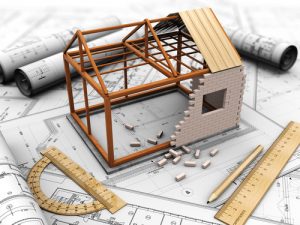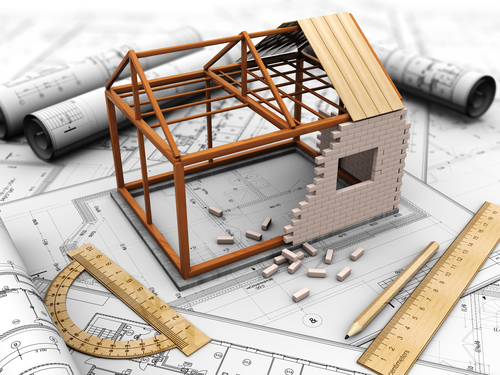This post first ran in 2018.
 In my 30-plus years as an architect, I’ve dealt with almost every kind of building project mistake. There are a few that come up over and over, delaying projects, frustrating clients and costing them additional money. These problems tend to arise from a few basic misconceptions. Here are seven of the most common mistakes.
In my 30-plus years as an architect, I’ve dealt with almost every kind of building project mistake. There are a few that come up over and over, delaying projects, frustrating clients and costing them additional money. These problems tend to arise from a few basic misconceptions. Here are seven of the most common mistakes.
Not Reviewing the Building Project Plans
The plans are the translation of your ideas into a buildable project.
At each meeting, your architect will want you to look over your project’s plans. She isn’t fishing for compliments, she’s giving you the chance to make sure what she’s created is what you envisioned.
Look them over carefully. If something you envisioned isn’t in them, speak up. Ask questions. If it’s not in the drawings, it won’t get built!
Not Moving Out During Construction
Not only is a construction site an uncomfortable place to live, it can be hazardous to your health. Fumes, nails, splinters – they can be hard to avoid during the building process.
If your contractor has to worry about your safety and comfort, and if he has to clean up completely at the end of each day, it can slow the process down.
Not Allowing the Architect to Supervise Construction
Sometimes clients want to save on an architect’s fees by supervising the building project themselves or passing the job to a general contractor. It seems logical, but this is a classic “penny-wise, pound-foolish” move.
A client may have the vision of the finished project, but she doesn’t usually have the knowledge or experience to monitor the thousands of small details that go into it. Contractors have a deep understanding of their special areas, but they may not understand how each aspect fits into the big picture.
The architect is the interpreter between these two. She’s the person most familiar with the whole plan, from the big picture down to the tiny details. She has the expertise to oversee all aspects of a project and can act as both quality-control monitor and interpreter, spotting potential problems before they occur and providing the client with options that won’t negatively affect the project as a whole.
Using Your Own Contractors
You have a contractor you’ve worked with in the past. Or your cousin is a plumber. Or you have a friend who recommends a “fabulous” painter.
A building project is like a symphony – it works best if everyone is playing in harmony. That’s tough to do if the conductor insists on replacing the orchestra members with individual instrumentalists who’ve never played together before and who have only played jazz, for example.
Your architect is the person most familiar with the project and the types of skills and experience necessary to get the job done efficiently, safely and cost-effectively. She has a trusted stable of contractors she’s worked with and communicates well with, and allowing her to use them can go a long way toward making a project run smoothly and with few surprises.
Acting As Your Own General Contractor
Along the same lines, you shouldn’t attempt to act as your own general contractor, even if you have some experience. First, it isn’t something you can do on weekends or after work – on a big building project, it’s a full-time job and requires excellent organization and management skills in addition to construction know-how.
Just as importantly, part of a general contractor’s job is to develop and maintain good relationships with subcontractors they know and trust and who will be available when a general contractor they know calls.
Do-It-Yourselferism
Even if a client understands that he may not be the best person to oversee the entire project, he may believe he can save money by doing part of the work himself. Again, this can end up costing him money in the long run.
Like the architect, each contractor has a team of people they know and trust, and with whom they work efficiently. Even if a client has the skills to do a particular job, insinuating himself into the project can throw a contractor’s work-flow off, potentially delaying things and increasing the risk of a costly mistake.
Buying Your Own Supplies
Big box stores like Home Depot are great. You can go in, choose from a bewildering array of appliances, fixtures, paints and supplies, and take it home the same day.
Nevertheless, you should resist the understandable urge to run out an buy your own supplies for your building project. In the end, the price is the same as you would pay with your “cousin’s discount” and all the hassles are not yours. Your architect and contractors are in the best position to find and purchase the supplies that will work best for your project. Whether it’s something as big as a refrigerator that fits an unusual kitchen space or as small as special screws to mount a shower stall, the architect and contractor can make sure the right item is there at the right time, avoiding delays and extra costs.
He or she not only knows about the quality of the supplies they select, but also have the clout to fix it quickly when something isn’t up to snuff. Bathtub you selected arrive with big scratch on the side? If you’ve bought it yourself, it’s your job to get it returned and replaced. If your contractor was the purchaser, however, it’s their problem, and they can often get things sorted out faster and more efficiently than can a client – after all, suppliers are eager to keep them happy because it means more return business.
You may have sensed a theme here, and it’s an important one: Let the professionals do their jobs! It will save you time, money and headaches.


